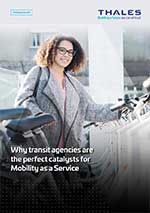This white paper delves into the rapidly evolving realm of Mobility as a Service (MaaS) and its implications for transit systems worldwide.
If you're a decision-maker or manager within a transit authority, understanding the strategic importance and operational nuances of MaaS is crucial. Your ability to effectively harness its potential can dramatically reshape the future of urban mobility in your jurisdiction.
Here is the overview of the document.
Here’s a summary.
The Advanced Approach to Commuting
MaaS offers more than just a route from A to B.
It's about creating a unified travel experience, allowing travellers to use a single platform for both navigation and payment.
The goal is to create one application that caters to all travel needs and benefits both parties.
- Adopting MaaS can help transit authorities modernize their services and adapt to changing customer demands, resulting in increased ridership and revenue streams.
- By offering more convenient, flexible, and efficient transportation options, MaaS can help improve commuters' overall quality of life and make public transit a more attractive and sustainable option for everyone.
However, bridging the gap between this vision and reality presents complexities.
Transit Agencies: Delivering MaaS
In the multifaceted realm of mobility, transit agencies are instrumental in realizing the full potential of MaaS.
With support from Thales, known for its expertise in banking, payments, and digital innovation, transit agencies can develop comprehensive MaaS solutions.
This platform provides a solution to combine open and closed fare systems while ensuring efficient Account Based Ticketing (ABT). The result is an optimal user experience combined with reduced operational costs.
Download the whitepaper

" Why transit agencies are the perfect catalysts for Mobility as a Service"
Navigating the MaaS Landscape: Key Questions
To navigate the MaaS landscape effectively, several questions arise:
- What are the expectations of travellers from MaaS?
- What are the challenges in creating an ideal MaaS system?
- What elements are essential for a successful MaaS system? How do transit agencies fit into this framework, and what benefits can they derive?
Multiple Stakeholders, Shared Objectives
Various entities, including tech giants, wallet providers, engine developers, and transit agencies, are all working towards enhancing the travel experience for users.
This also means accessing valuable data for improved network planning for transit agencies.
Additionally, governments have the responsibility to ensure accessible public transport, value for money, and promote environmentally friendly travel options.

Understanding Traveller Needs
The central component of MaaS is the journey planner.
However, travellers today demand more features and capabilities.
They want a platform where they can purchase all tickets, have flexible travel options, and can buy a ticket instantly if needed.
Challenges in MaaS Development
The vision for MaaS is ambitious, but there are obstacles.
These range from data privacy laws to intense competition among providers and technical challenges in integrating various ticketing systems.
Criteria for MaaS Success
To achieve a successful MaaS system, three main criteria are clear:
- Integration of fare rules across platforms
- Universal acceptance of fare media
- A high-quality mobile user experience
MaaS Development: Stepwise or Comprehensive Approach?
The full potential of MaaS relies on users having a single mobility and ticketing account.
Although different fare mediums might be used initially, the end goal is an integrated fare system.
Transit Agencies: Central to MaaS
Transit agencies have several advantages in the MaaS landscape.
They have close connections with governments, operate within regulated environments, and have the infrastructure to manage integrated fares.
Their expertise ensures proper user authentication and smooth operation within the MaaS ecosystem.
Thales D1: Enhancing MaaS
Thales Issuance as a service platform (D1), using EMV technology brings EMV technology to the centre of MaaS, ensuring security and consistency across different ecosystems.
It offers a range of benefits, from streamlined digital card creation to an improved user experience.
Good reading.
More on Mobility as a Service
Curious to learn more? Check out these resources.
- SCAG (Los Angeles, Orange, Riverside, San Bernardino and Ventura counties) – Mobility as a service feasibility white paper (July 2022)
Seven global implementations were reviewed for this study. They include Helsinki, Manchester, Vienna, Dublin, Stockholm & Gothenburg, West Midland, and Pittsburgh. Each policy framework element below summarizes critical lessons learned from these implementations. - Maas in Europe: Lessons from Helsinki, Vienna and Hanover - CEREMA (Dec 2019)
- The case of Mobility as a Service (MaaS): OECD (July 2021)
- Future mobility - insights -McKinsey (January 2023)
- Mobility as a Service – training – UITP (February 2022)
- MaaS: Key Principles for Successful Implementation – UITP (June 2019)
- Next-Generation Fare Media Solutions for Transport Ticketing (Thales transit offer)